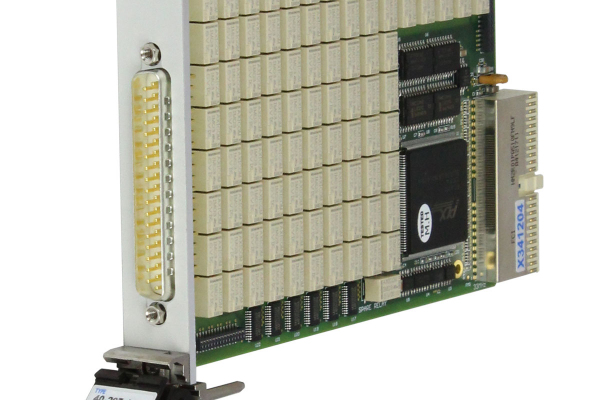Programmable Resistor Solutions for Sensor Simulation
An Electronic Control Unit (ECU) relies on information from a number of different sensors to monitor the equipment it is controlling—these may include measurements of temperature, strain, distance, etc. A Hardware-in-the-Loop (HIL) system employed to test the ECU needs to simulate the behavior of these sensors as accurately as possible to ensure that the ECU behaves on the test bench exactly as it would when operating in the real world. To help you understand programmable resistors, take a look at some of our technical resources here or scroll to bottom for video, success stories and articles:
Knowledgebase articles on Programmable Resistors
What is a Programmable Resistor?
Resistor chain used in a typical programmable resistor
A programmable resistor is designed to simulate the use of resistive sensors and variable resistors in systems when testing devices such as engine controllers. In their simplest form, our programmable resistors consist of a basic chain of resistance values switched in or out of circuit with reed relays, electro-mechanical relays or solid state switches. We also offer multi-channel programmable resistors with very fine value adjustment and high accuracy including programmable resistive bridges for strain gauge simulation. Take a look at our blog article: "What is a Programmable Resistor".
We offer a variety of PXI programmable resistor modules and PCI programmable resistor cards for sensor simulation to use in medical, automotive and aerospace applications. We offer different features for use in different applications, these include:
- Platform

- Solutions in both the PXI and PCI formats
- Ethernet or USB control of any of our PXI modules when installed in our LXI/ USB Chassis
- Number of Channels
- Between one and 18 channels
- Range
- Many resistance ranges are available with values from a short circuit to millions of Ohms
- Our PXI modules and PCI cards are available with a narrow setting range and very fine resolution for simulating sensors and strain gauges
- Resolution
- Resistance setting resolutions are available from 10Ω to 2mΩ for a wide range of applications
- Power Handling
- Generally 100mW for precision programmable resistors and up to 1W for standard programmable resistors
- We also offer a PXI programmable load module with up to 15W power handling (model 40-292)
- Minimum Resistance Value
- The lower the minimum resistance value required the greater the errors caused by relay contact resistance and copper trace losses.
- Generally, modules and cards with a low minimum resistance do not have as wide a range of resistance values as those with higher minimum resistances.
- Accuracy
- High accuracy requires careful design to ensure low loss paths, management of thermoelectric EMF and the use of higher stability resistors
- Calibration Port
- A calibration port allows the user to check the resistor channel without having to disconnect the front panel connector. It can be used to connect any of the resistor channels to a DMM to perform an accurate four terminal measurement.
- Custom Programmable Resistors
- If the desired accuracy, precision, range, number of channel, power handling, etc is not available, we are often able to configure custom builds or even design a new version of a PXI/PCI model.
Our programmable resistor modules are ideal for the simulation of resistive sensors with very fine adjustment and they have
the additional capability of being set as open and short circuit to simulate faults in the sensor connections to the
ECU. Specific versions of these modules have been developed to simulate Resistance Temperature Devices (RTD) (
PXI 40-262 series and
PCI 50-262 series) and strain gauges (PXI 40-265 series and
PCI 50-265 series).
Our entire range use real resistors, they do not use current loads or other electronic means to control the resistance value. Therefore they behave in exactly the same way as an actual resistor.
Applications for Programmable Resistors
Programmable resistors have many applications in automated test, verification and simulation systems:
- Strain Gauge Simulation - used in mechanical systems to measure the tension or compression of structural components.
Simulation requires extremely fine setting resolution with high accuracy and temperature stability.
- Temperature Sensor Simulation - simulation of resistance based temperature sensors such as positive or negative temperature coefficient thermistors. Resistance Temperature Detectors (RTDs) can be wire-wound or thin film. Both PT100 and PT1000 types can be simulated, requiring fine setting resolution.
- Pressure Sensor Simulation - for the simulation of pressure senders in mechanical systems or barometric pressure sensors in applications such as altimeters in the aerospace industry.
- Select on Test Resistance - a programmable resistor can be used in a test environment where a component's value is optimized at the production test stage.
- Load Resistor - where a circuit under test requires the connection of an external load.
- Position Sensor Simulation - rotary or linear position sensors in mechanical systems usually take the form of potentiometers and are used in applications such as throttle position senders in automotive systems.
- Switch Simulation - can be used to simulate the contacts of a worn or contaminated switch for automotive ECU (Engine Control Unit) testing.
- Fault Insertion - can be used for injecting fault conditions when testing the fault tolerance of aircraft or automotive control systems.








